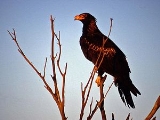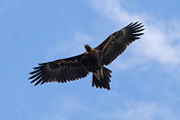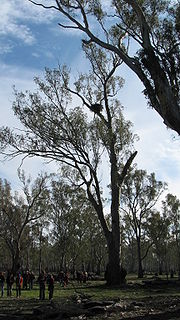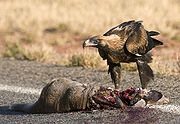
Wedge-tailed Eagle
Encyclopedia
The Wedge-tailed Eagle (Aquila audax), sometimes known as the Eaglehawk (an unfitting name, as it is among the largest raptors
) in its native range
, is the largest bird of prey
in Australia
, but it is also found in southern New Guinea
. It has long, fairly broad wings, fully feathered legs, and an unmistakable wedge-shaped tail. Because of both its tail and its size — it is one of the largest birds of prey
in the world — it can be identified at a glance as a "Wedgie" even by the non-expert.
The Wedge-tailed Eagle is one of twelve species of large predominantly dark-coloured eagles in the genus Aquila
found worldwide. A large brown bird of prey, it has a wingspan of up to 2.27 metres (7.4 ft) and a length up to 1.04 metres (3.4 ft).


 The female Wedge-tailed Eagle weighs between 3 and 5.77 kg (6.6 and 12.7 lb), while the smaller males weigh 2 to 4 kg (4.4 to 8.8 lb). Length varies between 81 and 106 cm (31.9 and 41.7 in) and the wingspan between 182 and 233 cm (71.7 and 91.7 in). The largest wingspan ever verified for an eagle was for this species. A female killed in Tasmania in 1931 had a wingspan of 2.84 m (9.3 ft), another female measured barely smaller at 2.79 m (9.1 ft). This eagle's great length and wingspan place it among the largest eagles in the world but its wings, at more than 65 cm (25.6 in) each, and tail, at 45 cm (17.7 in), are both unusually elongated for its body weight and 8-9 other eagle species regularly outweigh it.
The female Wedge-tailed Eagle weighs between 3 and 5.77 kg (6.6 and 12.7 lb), while the smaller males weigh 2 to 4 kg (4.4 to 8.8 lb). Length varies between 81 and 106 cm (31.9 and 41.7 in) and the wingspan between 182 and 233 cm (71.7 and 91.7 in). The largest wingspan ever verified for an eagle was for this species. A female killed in Tasmania in 1931 had a wingspan of 2.84 m (9.3 ft), another female measured barely smaller at 2.79 m (9.1 ft). This eagle's great length and wingspan place it among the largest eagles in the world but its wings, at more than 65 cm (25.6 in) each, and tail, at 45 cm (17.7 in), are both unusually elongated for its body weight and 8-9 other eagle species regularly outweigh it.
Young eagles are a mid-brown colour with slightly lighter and reddish-brown wings and head. As they grow older, their colour becomes darker, reaching a dark blackish-brown shade after about ten years. Adult females tend to be slightly paler than males. Although it rarely needs to be distinguished from other Aquila eagles, its long, wedge-shaped tail is unique to this species.
, including Tasmania
, and southern New Guinea
in almost all habitats, though they tend to be more common in lightly timbered and open country in southern and eastern Australia.
As the breeding season approaches, a pair of Wedge-tailed Eagles will perch close to each other and preen one other. They also perform dramatic aerobatic display flights together over their territory. Sometimes the male dives down at breakneck speed towards his partner. As he pulls out of his dive and rises just above her on outstretched wings, she either ignores him or turns over to fly upside down, stretching out her talons. The pair may then perform a loop-the-loop
. The wedge-tailed eagle usually nests in the fork of a tree between one and thirty meters above the ground, but if there are no suitable sites, it will nest on a cliff edge.
Prior to egg laying, both birds will either destroy the large stick nest or add new sticks and leaf lining to an old nest. The female usually lays two eggs and are incubated by both sexes. After about 45 days, the chicks hatch. At first, the male does all the hunting. When the chicks are about 30 days old, the female stops brooding them and joins her mate to hunt for food.
The young Wedge-tailed Eagles depend on their parents for food for up to six months after hatching. They leave only when the next breeding season approaches.
and ultraviolet
bands. This helps them spot prey and allows them to see rising thermals, which they can use to gain altitude while expending little energy.
 Most prey is captured on the ground in gliding attacks or (less frequently) in the air. Choice of prey is very much a matter of convenience and opportunity: since the arrival of Europeans, the introduced rabbit and Brown Hare have become the primary items of the eagle's diet in many areas. The Wedge-tails can eat almost anything of a suitable size, live-caught or as carrion
Most prey is captured on the ground in gliding attacks or (less frequently) in the air. Choice of prey is very much a matter of convenience and opportunity: since the arrival of Europeans, the introduced rabbit and Brown Hare have become the primary items of the eagle's diet in many areas. The Wedge-tails can eat almost anything of a suitable size, live-caught or as carrion
.
They display considerable adaptability, and have sometimes been known to team up to hunt animals as large as the Red Kangaroo
, to cause goat
s to fall off steep hillsides and injure themselves, or to drive flocks of sheep or kangaroo
s to isolate a weaker animal. Wedge-tailed Eagles may also kill young calves.
Carrion is a major diet item also: Wedge-tails can spot the activity of Australian Raven
s (sometimes known as crows) around a carcass from a great distance, and glide down to appropriate it. Wedge-tailed Eagles are often seen by the roadside in rural Australia, feeding on animals that have been killed in collisions with vehicles.
This impressive bird of prey spends much of the day perching in trees or on rocks or similar exposed lookout sites such as cliffs from which it has a good view of its surroundings. Now and then, it takes off from its perch to fly low over its territory. During the intense heat of the middle part of the day, it often soars high in the air, circling up on the thermal air currents that drift up from the baking ground below. Each pair occupies a home range, which may extend as little as 9 square kilometres to more than 100 square kilometres. Within this home range lies a breeding territory around the nest. The eagle patrols the boundary of this home range and advertises its ownership with high-altitude soaring and gliding flights. It may defend its territory by diving on intruders. Adults are avian apex predator
s and have no natural predators but must defend their eggs and nestlings against nest predators such as corvids.
from Tasmania
(Aquila audax fleayi
) is listed as endangered by the Environment Protection and Biodiversity Conservation Act 1999
(EPBC Act) with fewer than 200 pairs left in the wild. Like the Thylacine
, the eagle was once subject to a bounty in Tasmania, as it was believed to prey on livestock.
Decreasing numbers of Tasmanian devil
s may be beneficial to the Wedge-tailed Eagles in Tasmania, as it could reduce competition for roadkill and devil predation on Wedge-tailed Eagle young.
, Jeremy Clarkson
describes Wedge-tailed Eagles as gorging on roadkill at night, then occasionally being hit by trucks themselves, in gory detail.
The Empire of Atlantium
, a micronation
based in New South Wales
, Australia, features the Wedge-tailed Eagle on its seal.
A wedge-tailed eagle can be seen attacking Theodore Seville at the zoo in Alvin and the Chipmunks: The Squeakquel
.
Two wedge-tailed eagles have been seen on Zookeeper (film)
Bird of prey
Birds of prey are birds that hunt for food primarily on the wing, using their keen senses, especially vision. They are defined as birds that primarily hunt vertebrates, including other birds. Their talons and beaks tend to be relatively large, powerful and adapted for tearing and/or piercing flesh....
) in its native range
Range (biology)
In biology, the range or distribution of a species is the geographical area within which that species can be found. Within that range, dispersion is variation in local density.The term is often qualified:...
, is the largest bird of prey
Bird of prey
Birds of prey are birds that hunt for food primarily on the wing, using their keen senses, especially vision. They are defined as birds that primarily hunt vertebrates, including other birds. Their talons and beaks tend to be relatively large, powerful and adapted for tearing and/or piercing flesh....
in Australia
Australia
Australia , officially the Commonwealth of Australia, is a country in the Southern Hemisphere comprising the mainland of the Australian continent, the island of Tasmania, and numerous smaller islands in the Indian and Pacific Oceans. It is the world's sixth-largest country by total area...
, but it is also found in southern New Guinea
New Guinea
New Guinea is the world's second largest island, after Greenland, covering a land area of 786,000 km2. Located in the southwest Pacific Ocean, it lies geographically to the east of the Malay Archipelago, with which it is sometimes included as part of a greater Indo-Australian Archipelago...
. It has long, fairly broad wings, fully feathered legs, and an unmistakable wedge-shaped tail. Because of both its tail and its size — it is one of the largest birds of prey
Bird of prey
Birds of prey are birds that hunt for food primarily on the wing, using their keen senses, especially vision. They are defined as birds that primarily hunt vertebrates, including other birds. Their talons and beaks tend to be relatively large, powerful and adapted for tearing and/or piercing flesh....
in the world — it can be identified at a glance as a "Wedgie" even by the non-expert.
The Wedge-tailed Eagle is one of twelve species of large predominantly dark-coloured eagles in the genus Aquila
Aquila (genus)
Aquila is the genus of true eagles. It is often united with the buteos, sea eagles and other more heavyset Accipitridae, but more recently it appears as if they are less distinct from the more slender accipitrine hawks than believed...
found worldwide. A large brown bird of prey, it has a wingspan of up to 2.27 metres (7.4 ft) and a length up to 1.04 metres (3.4 ft).
Description



Young eagles are a mid-brown colour with slightly lighter and reddish-brown wings and head. As they grow older, their colour becomes darker, reaching a dark blackish-brown shade after about ten years. Adult females tend to be slightly paler than males. Although it rarely needs to be distinguished from other Aquila eagles, its long, wedge-shaped tail is unique to this species.
Breeding and habitat
Wedge-tails are found throughout AustraliaAustralia
Australia , officially the Commonwealth of Australia, is a country in the Southern Hemisphere comprising the mainland of the Australian continent, the island of Tasmania, and numerous smaller islands in the Indian and Pacific Oceans. It is the world's sixth-largest country by total area...
, including Tasmania
Tasmania
Tasmania is an Australian island and state. It is south of the continent, separated by Bass Strait. The state includes the island of Tasmania—the 26th largest island in the world—and the surrounding islands. The state has a population of 507,626 , of whom almost half reside in the greater Hobart...
, and southern New Guinea
New Guinea
New Guinea is the world's second largest island, after Greenland, covering a land area of 786,000 km2. Located in the southwest Pacific Ocean, it lies geographically to the east of the Malay Archipelago, with which it is sometimes included as part of a greater Indo-Australian Archipelago...
in almost all habitats, though they tend to be more common in lightly timbered and open country in southern and eastern Australia.
As the breeding season approaches, a pair of Wedge-tailed Eagles will perch close to each other and preen one other. They also perform dramatic aerobatic display flights together over their territory. Sometimes the male dives down at breakneck speed towards his partner. As he pulls out of his dive and rises just above her on outstretched wings, she either ignores him or turns over to fly upside down, stretching out her talons. The pair may then perform a loop-the-loop
Loop-the-Loop
Loop-the-Loop is the 16th single of the J-pop singer KOTOKO, release on October 20, 2010. The title track is used as the opening theme for the anime series Motto To Love-Ru, the sequel to the anime adaptation of To Love-Ru....
. The wedge-tailed eagle usually nests in the fork of a tree between one and thirty meters above the ground, but if there are no suitable sites, it will nest on a cliff edge.
Prior to egg laying, both birds will either destroy the large stick nest or add new sticks and leaf lining to an old nest. The female usually lays two eggs and are incubated by both sexes. After about 45 days, the chicks hatch. At first, the male does all the hunting. When the chicks are about 30 days old, the female stops brooding them and joins her mate to hunt for food.
The young Wedge-tailed Eagles depend on their parents for food for up to six months after hatching. They leave only when the next breeding season approaches.
Behaviour and diet
They are highly aerial, soaring for hours on end without wingbeat or effort, regularly reaching 1800 metres (5,905.5 ft) and sometimes considerably higher. The purpose of this very high flight is unknown. Their keen eyesight extends into the infraredInfrared
Infrared light is electromagnetic radiation with a wavelength longer than that of visible light, measured from the nominal edge of visible red light at 0.74 micrometres , and extending conventionally to 300 µm...
and ultraviolet
Ultraviolet
Ultraviolet light is electromagnetic radiation with a wavelength shorter than that of visible light, but longer than X-rays, in the range 10 nm to 400 nm, and energies from 3 eV to 124 eV...
bands. This helps them spot prey and allows them to see rising thermals, which they can use to gain altitude while expending little energy.

Carrion
Carrion refers to the carcass of a dead animal. Carrion is an important food source for large carnivores and omnivores in most ecosystems. Examples of carrion-eaters include vultures, hawks, eagles, hyenas, Virginia Opossum, Tasmanian Devils, coyotes, Komodo dragons, and burying beetles...
.
They display considerable adaptability, and have sometimes been known to team up to hunt animals as large as the Red Kangaroo
Red Kangaroo
The Red Kangaroo is the largest of all kangaroos, the largest mammal native to Australia, and the largest surviving marsupial. It is found across mainland Australia, avoiding only the more fertile areas in the south, the east coast, and the northern rainforests.-Description:This species is a very...
, to cause goat
Goat
The domestic goat is a subspecies of goat domesticated from the wild goat of southwest Asia and Eastern Europe. The goat is a member of the Bovidae family and is closely related to the sheep as both are in the goat-antelope subfamily Caprinae. There are over three hundred distinct breeds of...
s to fall off steep hillsides and injure themselves, or to drive flocks of sheep or kangaroo
Kangaroo
A kangaroo is a marsupial from the family Macropodidae . In common use the term is used to describe the largest species from this family, especially those of the genus Macropus, Red Kangaroo, Antilopine Kangaroo, Eastern Grey Kangaroo and Western Grey Kangaroo. Kangaroos are endemic to the country...
s to isolate a weaker animal. Wedge-tailed Eagles may also kill young calves.
Carrion is a major diet item also: Wedge-tails can spot the activity of Australian Raven
Australian Raven
The Australian Raven is the largest Australian member of the genus Corvus and one of three Australian species commonly known as ravens. It is a more slender bird than the Common Raven of the Northern Hemisphere but is otherwise similar...
s (sometimes known as crows) around a carcass from a great distance, and glide down to appropriate it. Wedge-tailed Eagles are often seen by the roadside in rural Australia, feeding on animals that have been killed in collisions with vehicles.
This impressive bird of prey spends much of the day perching in trees or on rocks or similar exposed lookout sites such as cliffs from which it has a good view of its surroundings. Now and then, it takes off from its perch to fly low over its territory. During the intense heat of the middle part of the day, it often soars high in the air, circling up on the thermal air currents that drift up from the baking ground below. Each pair occupies a home range, which may extend as little as 9 square kilometres to more than 100 square kilometres. Within this home range lies a breeding territory around the nest. The eagle patrols the boundary of this home range and advertises its ownership with high-altitude soaring and gliding flights. It may defend its territory by diving on intruders. Adults are avian apex predator
Apex predator
Apex predators are predators that have no predators of their own, residing at the top of their food chain. Zoologists define predation as the killing and consumption of another organism...
s and have no natural predators but must defend their eggs and nestlings against nest predators such as corvids.
Conservation status
The subspeciesSubspecies
Subspecies in biological classification, is either a taxonomic rank subordinate to species, ora taxonomic unit in that rank . A subspecies cannot be recognized in isolation: a species will either be recognized as having no subspecies at all or two or more, never just one...
from Tasmania
Tasmania
Tasmania is an Australian island and state. It is south of the continent, separated by Bass Strait. The state includes the island of Tasmania—the 26th largest island in the world—and the surrounding islands. The state has a population of 507,626 , of whom almost half reside in the greater Hobart...
(Aquila audax fleayi
Tasmanian Wedge-tailed Eagle
The Tasmanian Wedge-tailed Eagle is an endangered bird of Tasmania. It is a subspecies of the more common Wedge-tailed Eagle.-Description:...
) is listed as endangered by the Environment Protection and Biodiversity Conservation Act 1999
Environment Protection and Biodiversity Conservation Act 1999
The Environment Protection and Biodiversity Conservation Act 1999 is an Act of the Parliament of Australia that provides a framework for protection of the Australian environment, including its biodiversity and its natural and culturally significant places...
(EPBC Act) with fewer than 200 pairs left in the wild. Like the Thylacine
Thylacine
The thylacine or ,also ;binomial name: Thylacinus cynocephalus, Greek for "dog-headed pouched one") was the largest known carnivorous marsupial of modern times. It is commonly known as the Tasmanian tiger or the Tasmanian wolf...
, the eagle was once subject to a bounty in Tasmania, as it was believed to prey on livestock.
Decreasing numbers of Tasmanian devil
Tasmanian Devil
The Tasmanian devil is a carnivorous marsupial of the family Dasyuridae, now found in the wild only on the Australian island state of Tasmania. The size of a small dog, it became the largest carnivorous marsupial in the world following the extinction of the thylacine in 1936...
s may be beneficial to the Wedge-tailed Eagles in Tasmania, as it could reduce competition for roadkill and devil predation on Wedge-tailed Eagle young.
In popular culture
On episode 4 of season 2 of QIQI
QI is a British comedy panel game television quiz show created and co-produced by John Lloyd, hosted by Stephen Fry, and featuring permanent panellist Alan Davies. Most of the questions are extremely obscure, making it unlikely that the correct answer will be given...
, Jeremy Clarkson
Jeremy Clarkson
Jeremy Charles Robert Clarkson is an English broadcaster, journalist and writer who specialises in motoring. He is best known for his role on the BBC TV show Top Gear along with co-presenters Richard Hammond and James May...
describes Wedge-tailed Eagles as gorging on roadkill at night, then occasionally being hit by trucks themselves, in gory detail.
The Empire of Atlantium
Empire of Atlantium
The Empire of Atlantium is a micronation and secular,pluralist progressive lobby group based in New South Wales, Australia.Micronations: The Lonely Planet Guide to Home-Made Nations describes Atlantium as "a refreshing antidote to the reactionary self-aggrandisement of so many micronations", and...
, a micronation
Micronation
Micronations, sometimes also referred to as model countries and new country projects, are entities that claim to be independent nations or states but which are not recognized by world governments or major international organizations...
based in New South Wales
New South Wales
New South Wales is a state of :Australia, located in the east of the country. It is bordered by Queensland, Victoria and South Australia to the north, south and west respectively. To the east, the state is bordered by the Tasman Sea, which forms part of the Pacific Ocean. New South Wales...
, Australia, features the Wedge-tailed Eagle on its seal.
A wedge-tailed eagle can be seen attacking Theodore Seville at the zoo in Alvin and the Chipmunks: The Squeakquel
Alvin and the Chipmunks: The Squeakquel
Alvin and the Chipmunks: The Squeakquel is a 2009 American comedy film directed by Betty Thomas. The film stars Zachary Levi, David Cross, Jason Lee, and the voices of Justin Long, Jesse McCartney, Matthew Gray Gubler, Christina Applegate, Amy Poehler, and Anna Faris...
.
Two wedge-tailed eagles have been seen on Zookeeper (film)
Zookeeper (film)
Zookeeper is a 2011 comedy film starring Kevin James, and featuring the voices of Adam Sandler, Sylvester Stallone, Nick Nolte, Don Rickles, Judd Apatow, Jon Favreau, Cher and Faizon Love. The film contains computer animation, is produced by Sandler's production company, Happy Madison, and is...

